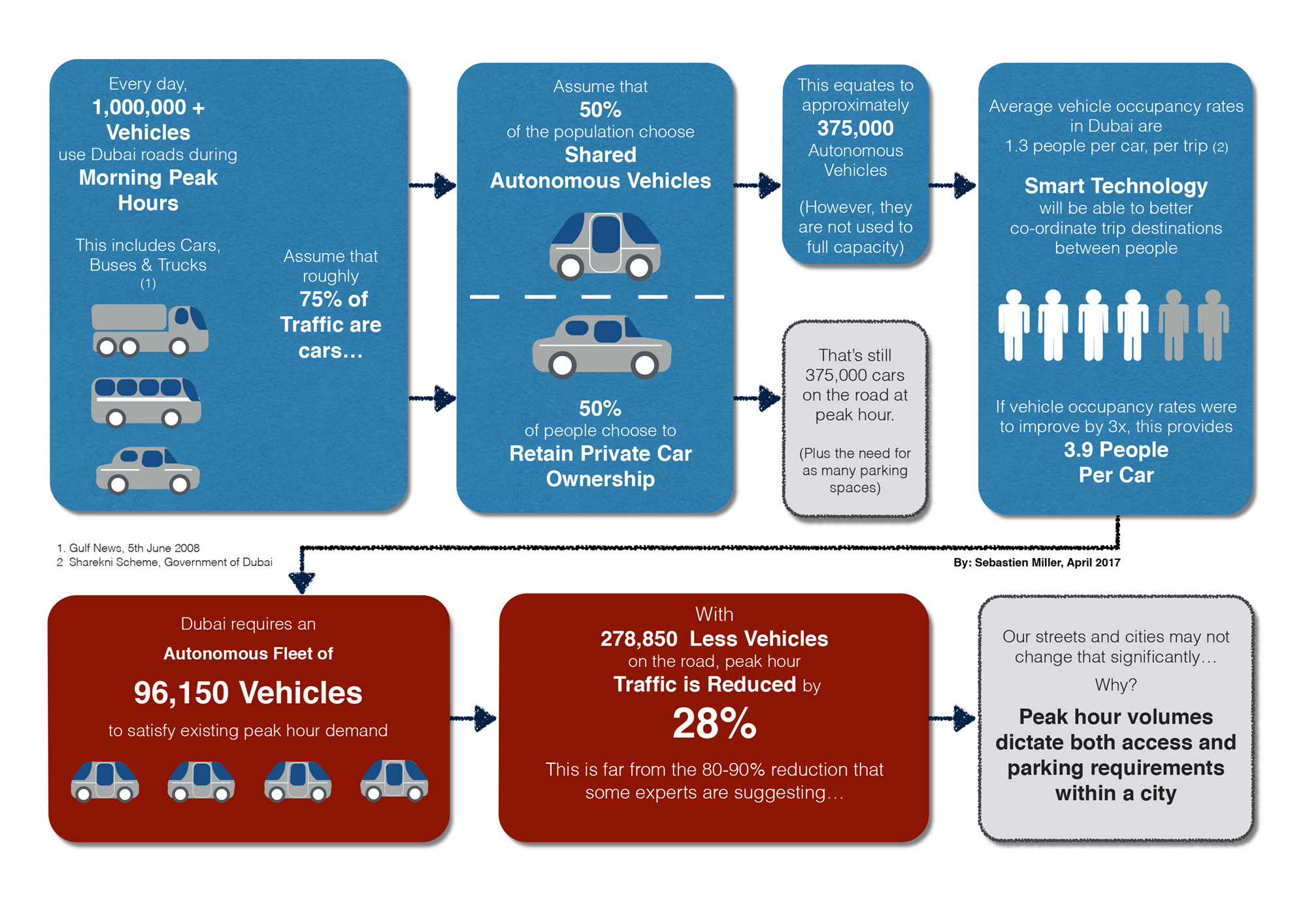Autonomous Vehicles (AVs) promise to change our commuting patterns in the not too distant future. Reduced traffic volumes and congestion will allow us to remove excess travel lanes and mass parking facilities.
With vehicle infrastructure taking up to 50% of city space, this would release significant land for redevelopment. It could allow for higher densities, more affordable inner-city housing options, networks of new linear parks, and the exploration of urban farming options. City living would transform.
Are we overestimating the benefits?
Some professionals cite an 80 – 90% traffic reduction by shifting to AVs. However, the number of autonomous vehicles required within a city is not dictated by overall daily usage, but by peak usage. This is the most important point in understanding the potential impacts of AVs on commuting patterns and city forms (see diagram).
Congestion will be reduced, but it will never be eliminated as most cities have radial transport networks that focus congestion on central employment districts. Electric AVs need parking spaces to recharge after the peak hour rush, especially in metropolitan areas that have commuting times of two hours plus. Convenience dictates that these are located in or near the CBD, so downtown areas will still need on-street and dedicated parking structures.
Autonomous vehicles will free up urban space to key streets, districts or plazas, but not citywide and unfortunately, not in the quantities we expect. Only a major uptake in public transportation or more flexible working hours could offset the need for vast fleets of AV’s to satisfy our peak hour commuting demands.
We are being sold an autonomous vision that is in equal parts intimately personal and seamlessly efficient. However, a million commuters in private cars (automated or not) is still a million vehicles on our roads.
Evolution or revolution?
A direct substitution between private and autonomous vehicles is unrealistic in our complex and fluid world. It is more likely that shared AVs will offer a new layer of urban transit, just as we have taxi, bus, bicycle and metro to choose from. It will give us more options and help to make our cities more efficient and democratic, especially to those who are mobility impaired.
Traffic reductions: smaller than expected? This graphic uses Dubai as an example and shows that most projections are overconfident when estimating potential traffic reductions.
Could AVs create more congestion?
Paradoxically, autonomous vehicles could deliver more traffic on the road as we see reduced costs and increased independence. As I type this article, (working from home), I’m thinking of things I have to do today. A business meeting in town; collect the kids from school at 3:00; pick up my wife from work at 4:30. We are a one-car family that tries to save on costs and minimise our carbon footprint, so I bundle these tasks into a single loop-trip. The downside is the inefficient use of my time. It will take the better part of two hours. If the family had the benefit of a cheap and efficient AV system, we would likely make three individual trips, increasing both congestion and distances traveled.

What about the battery issue?
One issue rarely discussed with electric cars is the decommissioning and recycling of batteries. Chemical point-source pollution is likely to be the next major environmental concern as we develop fleets of electric vehicles. Compared to the effects of carbon and global warming, it is the lesser of two evils. However, government and industry need to think about how to manage this before we trade one environmental disaster for another.
AVs within next 10-15 years?
The rapid pace in technology means that AVs are likely to be commercially available within the next 10-15 years. They require 5G networks (expected to launch in 2020) to communicate with each other while in motion, and navigate unpredictable human drivers. In 2015 self-driving trucks started live testing on freeways in Nevada. They safely navigated public auto-routes, but had a human driver on-board to monitor all systems. City officials and governments are already preparing for the change in commuting patterns, with forward thinking city regions introducing pioneering AV policies.
Dubai – global R&D centre for driverless transport?
Dubai recently launched a strategy that aims for 25% of all trips to be autonomous by 2030. This 25% figure also includes the existing automated Dubai Metro system, which one could argue does not count as an autonomous vehicle. Nor does it specify what percentage of trips will be shared. Regardless of this detail, the Emirate has introduced an autonomous test vehicle as part of its commitment to a self-driving future. Such a vision goes beyond city efficiency. Dubai hopes to ‘turn itself into the world’s largest R&D lab for driverless transportation’ and will capitalise on the economic revenues associated with this.
Conclusion
For autonomous transportation to deliver a meaningful reduction in vehicle numbers we need to rethink car ownership. Cities need a vision where shared-use (rather than private) models of autonomous transportation are promoted. Policy development must not naively view AVs as a like-for like swap with private cars. Such a goal requires governments, city planners, the auto-industry and third party operators to come together with a common approach and vision. It would be the missed opportunity of the century if we do not get this right.

